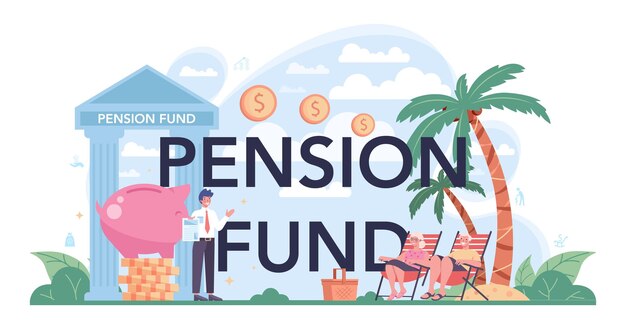The Complete Guide to Retirement Accounts
Ellie Moore

Photo: The Complete Guide to Retirement Accounts – Which One is Right for You?
Retirement is a significant milestone in life, marking the end of one’s working years and the beginning of a well-deserved rest. However, ensuring a secure financial future in retirement involves careful planning and the right tools. One of the most crucial steps in this planning process is selecting the appropriate retirement account. With numerous options available, choosing the best one can be overwhelming. In this comprehensive guide, we will delve into the various types of retirement accounts, their features, and what they offer. Our goal is to help you understand which retirement account is right for you, making your financial planning journey smoother and more informed.
Understanding Retirement Accounts
Before we dive into the specifics of each type of retirement account, it's essential to understand the broader context. Retirement accounts are designed to help individuals save money for their golden years by offering tax benefits and investment opportunities. These accounts can be employer-sponsored or self-directed, and they vary in terms of contribution limits, investment options, and withdrawal rules.
- Employer-Sponsored Accounts
- 401(k) Plans
- What is a 401(k)?
A 401(k) plan is a type of employer-sponsored retirement plan that allows employees to contribute a portion of their salary on a pre-tax basis. The contributions are then invested in a variety of assets such as stocks, bonds, and mutual funds. - Benefits of 401(k) Plans
401(k) plans offer several benefits:- Tax Deductions: Contributions are made before taxes, reducing your taxable income.
- Employer Matching: Many employers match a portion of the contributions made by employees, effectively providing a form of free money.
- Compounding Returns: The longer you stay in the plan, the more time your money has to grow, thanks to compound interest.
- What is a 401(k)?
- Other Employer-Sponsored Plans
- 403(b) Plans: These plans are similar to 401(k) plans but are primarily used by employees in non-profit organizations and public schools.
- Thrift Savings Plan (TSP): This plan is available to federal employees and offers a range of investment options.
- 401(k) Plans
- Self-Directed Retirement Accounts
- IRAs (Individual Retirement Accounts)
- What is an IRA?
An IRA is a personal retirement account that you set up and manage yourself. There are two main types: Traditional IRAs and Roth IRAs. - Traditional IRA
- Contributions and Withdrawals
Contributions to a Traditional IRA are tax-deductible, and the funds grow tax-deferred. You'll pay taxes when you withdraw the money in retirement. - Eligibility
Anyone with earned income can open a Traditional IRA, but eligibility for tax deductions depends on income levels and filing status.
- Contributions and Withdrawals
- Roth IRA
- Contributions and Withdrawals
Contributions to a Roth IRA are made with after-tax dollars, so you've already paid income taxes on this money. The funds grow tax-free, and withdrawals are tax-free if certain conditions are met. - Eligibility
Roth IRAs have income limits on who can contribute, and the amount you can contribute also has limits.
- Contributions and Withdrawals
- What is an IRA?
- IRAs (Individual Retirement Accounts)
- Other Retirement Account Options
- Annuities
- An annuity is a contract with an insurance company where you pay a lump sum or installments in exchange for a series of payments over time. Annuities can provide predictable income in retirement.
- There are various types of annuities, including fixed, variable, and indexed annuities, each offering different benefits and risks.
- Annuities
Choosing the Right Retirement Account
Choosing the right retirement account depends on several factors, including your financial situation, investment goals, and personal preferences. Here are some key considerations:
- Financial Situation
- Income Level: If you have a high income, you might be eligible for larger contributions to certain accounts like 401(k) or Traditional IRA.
- Debt: If you have high-interest debt, you may want to prioritize debt repayment over retirement savings.
- Investment Goals
- Risk Tolerance: Some retirement accounts offer more conservative investment options (e.g., bonds), while others allow for riskier investments (e.g., stocks).
- Long-term Growth: If you have a long time horizon before retirement, you might opt for accounts that offer higher potential returns.
- Personal Preferences
- Tax Strategy: If you expect to be in a higher tax bracket in retirement, a Roth IRA might make more sense since withdrawals are tax-free.
- Flexibility: Some accounts offer more flexible withdrawal rules than others.
Real-Life Examples
Let's consider two hypothetical individuals to illustrate how different retirement accounts might suit different needs.
- John and Jane Doe
- John: John is 30 years old and just started his career. He has a moderate income and is looking to save for retirement. He contributes to his employer’s 401(k) plan to take advantage of the employer matching and start building a nest egg early. He also opens a Traditional IRA to supplement his savings.
- Jane: Jane is 45 and has a higher income but also significant student loans. She prioritizes paying off her loans quickly and then focuses on contributing to a Roth IRA to ensure that her retirement savings grow tax-free.
- Sarah Johnson
- Sarah is 60 years old and nearing retirement. She is concerned about predictable income in her golden years and decides to invest in an annuity to secure a steady stream of income without worrying about market fluctuations.
Conclusion
Selecting the right retirement account is a crucial step in securing your financial future. Each type of account has its unique features and benefits, making it essential to understand what each offers before making a decision. Whether you opt for an employer-sponsored plan like a 401(k), a self-directed IRA, or an annuity, what matters most is that you start early, contribute consistently, and choose options that align with your financial situation and investment goals.
By taking the time to research and understand your options, you’ll be better equipped to make informed decisions that set you up for financial success in retirement. Remember, it’s never too late to start planning, and every step towards securing your financial future is a step in the right direction.
Additional Tips and Resources
Tips for Maximizing Your Retirement Savings
- Start Early: The power of compound interest can't be overstated. The earlier you start saving, the more time your money has to grow.
- Take Advantage of Employer Matching: If your employer offers matching contributions, contribute enough to maximize these benefits.
- Diversify Your Investments: Spread your investments across various asset classes to minimize risk.
- Regularly Review and Adjust: Periodically review your investment portfolio and rebalance it as needed.
Recommended Reading and Resources
- IRS Publications on Retirement Accounts
- The Internal Revenue Service (IRS) provides detailed information on all types of retirement accounts, including rules for contributions and withdrawals.
- Financial Planning Websites
- Websites like NerdWallet, Investopedia, and Kiplinger offer comprehensive guides on retirement planning, including comparisons of different retirement accounts.
- Consult with a Financial Advisor
- Sometimes, seeking professional advice can provide personalized insights tailored to your unique situation.
By combining thorough research with practical advice, you can navigate the world of retirement accounts with confidence, ensuring that you make the best possible choices for your financial future.
Finance & Investment
View All
January 15, 2025
Latest Kia Finance Offers 2025Master online success! Expert SEO content, guided by E-E-A-T, is non-negotiable for top rankings, building trust, and satisfying Google's updates.
Ellie Moore

June 8, 2025
Consumer Finance Tips for Smarter SpendingGo beyond basic SEO! Discover how expert content, built on user intent & E-E-A-T, ranks high and truly engages your audience.
Ellie Moore

January 14, 2025
What is the International Finance CorporationUnlock top rankings with expert SEO content. Create high-value, credible content that satisfies user intent & search algorithms for true authority.
Ellie Moore

April 17, 2025
Peace Finance Solutions for YouMaster expert SEO content: craft high-quality, authoritative, and trustworthy information that satisfies users & search engines for top rankings & growth.
Ellie Moore

May 30, 2025
Yearn Finance Crypto ExplainedMaster expert SEO content with our guide! Dominate search rankings, attract high-quality traffic, build authority, and drive conversions for your brand.
Ellie Moore

June 27, 2025
Auto Repair Financing Help When You Need ItWhat is expert SEO content? Go beyond keywords to deliver genuine value, build trust, and rank higher. Learn to satisfy users and search engines for organic gro...
Ellie Moore
Insurance
View AllProtect your future with Premium State Farm Insurance. Explore comprehensive plans for personal & commercial risks, ensuring financial stability and peace of mi...
Ellie Moore
Discover how long-term care insurance supports future healthcare needs and offers financial stability for aging individuals.
Ellie Moore
Secure your health & finances! Discover how to confidently select the best, most affordable top-rated health insurance plans for comprehensive coverage.
Ellie Moore
Get comprehensive protection with Essential Foremost Insurance Plans. Our guide helps policyholders, agents & risk managers navigate specialized coverage & secu...
Ellie Moore
Unlock peace of mind with Ultimate Nationwide Insurance Plans. This guide helps you secure comprehensive protection for your assets, health, and financial futur...
Ellie Moore
Navigate dental insurance with our guide. Find essential plans for comprehensive coverage, financial security, and peace of mind for you or your business.
Ellie Moore
Education
View AllUnderstand the causes, effects, and potential solutions to the student loan debt crisis. Learn what can be done to ease this financial burden.
Read MoreHow does social media affect learning and behavior? Uncover the positive and negative effects of social platforms on students today.
Read MoreStrong school-community partnerships can drive student success. Discover the benefits and strategies for effective collaboration.
Read MoreEthics in education is vital for balanced learning. Learn how to teach morality alongside knowledge transfer in today’s classrooms.
Read MoreCompare Montessori and traditional education methods. Discover which approach is more effective for fostering creativity and independence in students.
Read MoreForest schools offer hands-on learning in nature. Discover how this approach nurtures creativity, problem-solving, and environmental awareness in students.
Read MorePopular Post 🔥
View All
1
2
3
4
5
6
8
9
10
Health






Automotive
View All
August 27, 2025
Premium Automotive Services For High End Cars
Luxury & exotic cars demand premium care. Discover why specialized services are essential to preserve their performance, stunning aesthetics, and long-term valu...

August 30, 2025
SZN Automotive LLC Car Care For All Seasons
Drive confidently all year! SZN Automotive LLC provides comprehensive seasonal car care to prevent issues, enhance safety, & save you money.

February 15, 2025
Vehicle Recalls: What You Need to Know
Concerned about a vehicle recall? Learn what steps to take and how to stay informed about recalls affecting your car. Stay safe on the road!

August 18, 2025
What To Expect From An Automotive Technician Job
Beyond wrenches: Discover the modern automotive technician career. It's a dynamic, high-tech role focused on diagnostics, tech, and problem-solving.

February 9, 2025
Ultimate Car Camping Guide: Gear & Road Trip Tips
Planning a car camping trip? Get the ultimate guide on gear, setups, and essential road trip tips for an unforgettable adventure!

September 5, 2025
Top Automotive Swap Meets Near Me This Year
Unearth automotive treasures at vibrant swap meets! Find rare parts, classic cars, & connect with enthusiasts. Your guide to top events this year.

















